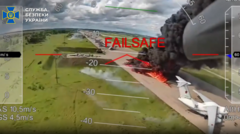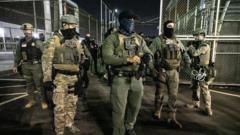In a bold and meticulously planned operation, Ukraine executed a drone strike targeting Russian airbases, raising questions about the future of Russian military capabilities and the direction of the ongoing conflict.
Ukraine's Drone Strategy: A Revolutionary Shift in Warfare

Ukraine's Drone Strategy: A Revolutionary Shift in Warfare
Operation Spider's Web marks a significant escalation in Ukraine's tactical approach against Russian aerial capabilities.
Days after the striking Operation Spider's Web, Ukraine is still analyzing the massive implications of Sunday’s aerial assault on Russia's military aviation assets. The Security Service of Ukraine (SBU), which orchestrated the attack, has released striking drone footage and satellite images showcasing the damaged Russian aircraft at Olenya, Ivanovo, Dyagilevo, and Belaya airbases. As the dust settles, experts are heralding this operation as possibly one of the most significant military maneuvers in Ukraine’s history.
"This can be considered one of the most brilliant operations in our history," stated Roman Pohorlyi, a founder of the military analysis group DeepState. He emphasized that this operation demonstrates Ukraine's strength and creativity, effectively showcasing its capacity to strike deep into enemy territory. With information predominantly sourced from the SBU, the agency has been keen to highlight its success, especially in light of the Kremlin's muted response.
Ukrainian President Volodymyr Zelensky reiterated claims that 41 aircraft suffered considerable damage, with many deemed irreparable. He emphasized that if a ceasefire had been in effect, this operation would never have transpired. The aftermath of the operation, captured in a four-minute video compilation from SBU cameras mounted on 117 drones, vividly illustrates the chaos unleashed upon Russian bombers and cargo planes as they were caught off-guard.
The footage revealed unprecedented details, including drones targeting strategic areas such as fuel tanks in the wings of aircraft, igniting propellant fires as nearby planes erupted in flames. Fast-moving images tracked the assaults on A-50 AWACS aircraft, critical for targeting detection, raising concerns about their dwindling numbers within the Russian fleet.
Signals point toward a concerning narrative for Russia; with the loss of the A-50 aircraft, experts speculate a drastic shift in aerial surveillance capability. Defense analyst Serhii Kuzan remarked on the implications of this loss, reinforcing it as a strategic issue Russia cannot resolve rapidly, particularly given its current manufacturing dilemmas.
Adding another layer of complexity, the SBU hinted at the unique logistical preparations of the operation. Drones were covertly transported in specially constructed containers mounted on trucks, suggesting meticulous planning far beyond standard operations. The video evidence of these conversions showcases a level of sophistication in drone warfare previously unseen in the conflict.
Anatolii Khrapchynskyi, an aviation expert, posited that this operation marked a military turning point for Ukraine, damaging Russia's image and military effectiveness. As tensions simmer, the global community watches closely, with former President Donald Trump noting ongoing dialogues with Putin regarding Ukraine's recent actions. However, he warns that further retaliation from Russia may be inevitable.
This drone operation, punctuated by precise execution and innovative logistics, not only showcases Ukraine’s tactical innovation but also speaks volumes about the evolving nature of modern conflict, where technology continues to shape the landscape of warfare.






















